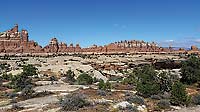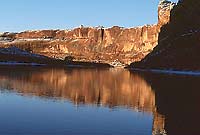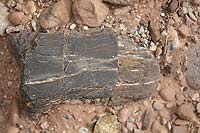What a tale the rocks can tell! The story includes Sahara-like sand dunes devoid of life, the roars of dinosaurs warning of approaching velociraptors, the gentle swishing of waves upon the shore, and predatory sharks lurking in ancient seas.
Geologists know this story and they sometimes speak in technical terms such as subduction, orogeny, superposition, facies, stratigraphy, deposition, erosion, cross-bedding, and disconformity to name a few. There is a whole language devoted to describing the science of geology, but it is the story behind the language, like reading between the lines, that I enjoy the most.
 Of course, the final product of millions of years of erosion, deposition, uplift, and subduction is the outstanding red rock scenery that abounds in the Canyon Country of southern Utah. It is the arches, bridges, canyons, plateaus, spires, and awe-inspiring hoodoos that capture our attention and delight our visual senses. But what is behind or better within the layers of sandstone, limestone, and shale, that is real story about this scenery.
Of course, the final product of millions of years of erosion, deposition, uplift, and subduction is the outstanding red rock scenery that abounds in the Canyon Country of southern Utah. It is the arches, bridges, canyons, plateaus, spires, and awe-inspiring hoodoos that capture our attention and delight our visual senses. But what is behind or better within the layers of sandstone, limestone, and shale, that is real story about this scenery.
Geologists have a great tool to help them understand the past – the present. They observe the processes of erosion and weathering and deposition to recreate what happened in the past. They analyze fossils, chemical compositions, and sedimentary deposits to determine past environments and the creatures that inhabited these prehistoric landscapes.
 Time is also different to a geologist. They generally don’t speak in terms of days or weeks, but in Periods, Epochs, or Eras, conglomerates of time bundled by millions of years. In the grand scheme of things, “next week” has little meaning to them.
Time is also different to a geologist. They generally don’t speak in terms of days or weeks, but in Periods, Epochs, or Eras, conglomerates of time bundled by millions of years. In the grand scheme of things, “next week” has little meaning to them.
So where to start? In Arches National Park the oldest rock strata visible is from the Pennsylvanian Period, roughly some 330 million years ago, give or take a few weeks. Near the Arches Visitor Center is a lens of limestone – you can see it in the road cut where the highway passes by the Visitor Center – or you can take a walk along Bloody Mary Wash to see it up-close.
If you choose the later, spend some time looking for fossils embedded in the limestone formation. There are corals and crinoids, skeletons of a creature known as “sea lilies”, that live in the ancient ocean that once covered this spot.
Fast forward to the whitish dune-like Navajo Sandstone that outcrops between Courthouse Wash and Balanced Rock. These petrified dunes are literally that, ancient sand dunes that have once covered the region. Plants grew in the dunes and playas existed that held water, just like the dunes along the Oregon Coast today. 
Younger strata that sits atop the Navajo Sandstone are the three members that once made up the Entrada Sandstone, but now have been split from that formation. They are, in order of age of oldest to youngest, the Carmel Formation’s Dewey Bridge Member, the Entrada Sandstone’s Slick Rock Member, and the Curtis Formation. These three layers are the predominant layers in Arches National Park which hold the majority of the arches.
The historic environment of this period? Tidal influence, windblown sands, stream depositions. A far cry from today’s landscape where the sea is about a thousand miles away.
So, as you travel through Canyon Country, see the present but consider the past. Seek to understand the scope of geologic time and how reading the rocks can tell an incredible story worth listening to.